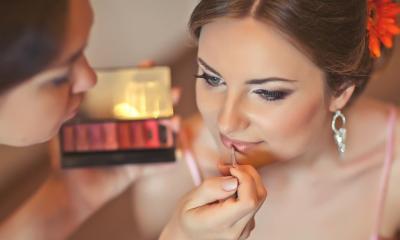
Beauty salons offer a range of treatments including sunbeds, hair removal, weight loss, facials and manicures. Some therapists work from home or are mobile. Our practical guide will help you start up and run your own beauty business.
- Research your market - who will use your beauty salon?
- your target market
- Decide which services your beauty salon will offer
- What should you charge for different beauty treatments?
- Offering discounts
- Buy an existing beauty salon
Research your market - who will use your beauty salon?
Customers - who and how many?
Once you have decided what sector of the market you are targeting the next step is to think about how many people are likely to use your services.
Consider the type of people who live and work in your area. For example, are they mostly wealthy, or would a middle of the road salon be more appropriate? Are there lots of elderly people living in the area, who might appreciate a mobile service? What about local nursing homes and residential homes? What other outlets are attracting people to the area where your salon will be? For example, a parade of shops which included a florist, a hairdressing salon and a ladies clothes shop would be drawing lots of women who might be interested in your services. Bear in mind too that men are increasingly prepared to have certain treatments to help them maintain a well-groomed appearance. You could introduce services that will appeal especially to male customers - like sports massage. Facials for men have become much more popular too.
If you decide to offer treatments and services as a unisex salon, try to make sure that your salon premises are not intimidatingly feminine.
What competition will your beauty salon face?
Once you have decided who your potential customers are, the next stage is to find out how well they are already served.
How many other beauty salons are there in your area? Don't forget that many other establishments also offer beauty treatments, such as express beauty bars, hairdressing salons, male grooming salons, health spas or hotels. How many offer the same services that you intend to offer? These are your direct competitors.
Find out what your direct competitors are like:
- what sector of the market are they aiming at
- what sort of image do they project
- are they part of a franchise operation or are they independents
- do they specialise at all
- are they large salons with several therapists or small outlets
Make a note of the prices charged for treatments, particularly the ones that you intend to offer.
Remember that nearly two-thirds of businesses offering beauty treatments don't have salon premises but operate a mobile service or work from home. Try to make a realistic estimate of this type of competitor too.
Don't forget that market research can be ongoing. Once your business is up and running, talk to your customers. Try to find out what are their likes and dislikes. Use their comments to help you develop your business so that it meets your customers' requirements.
Research current trends in the beauty sector, plus legal and tax issues
Decide which services your beauty salon will offer
The range of services you decide to offer will depend on:
- your (and your employees') skills and expertise
- the space you will have available in your salon
- the amount of money you invest in equipment
- local demand
There's a huge range of salon equipment available enabling therapists to offer clients all sorts of different treatments. For example there are sunbeds, laser systems, inch-loss systems and so on. They are all expensive and, in the early days, it might be worth offering a limited range of popular treatments such as lash and brow treatments, waxing, spray tanning, facials and manicures, which do not require too much expensive equipment. As your salon establishes its reputation and your clientele builds up you can invest in new items of equipment and increase the range of treatments you offer.
Space will always be a factor influencing the services you provide. Each therapist will normally need their own treatment room equipped with couch, wash hand basin and so on. You will also need an area where customers can wait when they first arrive as well as shower, changing and toilet facilities. In a small salon premises this may not leave you much room to install equipment such as sunbeds.
Don't forget that your reception area should ideally be large enough for you to display a range of products to sell to your customers for use at home.
Quality standards
No matter how large or small your salon is it is very important that it projects a hygienic and professional image. Make sure that:
- the salon is always clean, tidy and welcoming
- good quality products are used
- staff are well groomed and smart
- a first class service is provided to customers
- you create a welcoming atmosphere with music, good lighting, complimentary refreshments etc
Advertising your services
Whatever services you decide to offer, it's essential to make sure that your potential customers know about you and the services you offer.
Don't overlook the potential of your window display if you have salon premises - a bright, regularly changed display will attract passing trade. For example, you could use your window space to promote spring specials - a package of treatments to help customers get into shape for the summer. You might consider advertising hen parties or birthday parties at which you provide treatments and refreshments.
Think about having leaflets printed which contain details of the treatments you provide, the price and any special offers or promotions. For example, you might offer one free treatment if a course of six is booked and paid for in advance. What about a free or discounted treatment for customers who introduce a friend - this can help to widen your customer base.
It's a very good idea to set up your own website to promote your business, telling people about the range of treatments available. You could offer an online booking facility for appointments, and make online sales of body and facial products. You could send out email newsletters to people who register on your website telling them about new treatments and products. You could think about offering promotional deals on voucher websites like Groupon or on beauty treatment booking websites like Treatwell. Think too about using online social media like Facebook or Instagram to highlight promotions and special offers.
What should you charge for different beauty treatments?
Income from treatments
Assuming that you have a steady stream of customers, the amount you can earn is limited by the number of treatments that you or your staff can fit into a day. This depends on a number of factors:
- your opening hours
- the number of treatment rooms you have
- how fast you and your staff can work - college leavers will be much slower than more experienced therapists
- the type of treatments offered - for example a facial may take much longer than an electrolysis session
- the amount of time you have to spend doing other things
There are lots of things that you will need to attend to besides giving treatments. Some jobs can be done when the salon is closed, others won't wait. Think about the following:
- answering the telephone
- initial consultations with new clients (free of charge)
- cleaning up after each client
- making refreshments for clients
- waiting for facilities to become free when the salon is busy
- supervising and monitoring trainees
- monitoring, ordering and buying stock
- going on training and refresher courses
Bear in mind that, even in a busy salon, there will be certain times of the day when you find yourself waiting for your next customer. Because more and more people are in full-time employment there may well be periods during normal working hours when demand for your services is low. On the other hand, if you're prepared to stay open late, you could find that the early evening is much busier. If you are going to work as a mobile beauty therapist, a large part of your working day will be spent travelling to your customers, setting up and packing away your materials.
Don't forget that your staff (if you employ any) are unlikely to be as motivated to work hard as you are, so they may get less work done.
Estimating the maximum number of treatments each day
As a trained and experienced therapist, you will already have a good idea how long it normally takes you to complete each of the treatments you will offer. From this you can work out an average treatment time. When you have priced each of the treatments you will offer you can also work out an average treatment price.
Once you have decided on your opening hours, work out how many average treatment times you could fit into the day. It would probably be prudent to divide this by two to work out the number of treatments that you will actually give, particularly in the early days. Do the same for each therapist you employ. Then multiply the number of treatments you will provide by the average price for each treatment - this will help you to estimate your monthly income. Bear in mind that you're also likely to sell a number of packages which you'll price more cheaply than the normal cost of the individual treatments included in the offer. This will bring down your average treatment price.
Don't forget to add an amount on for retail sales of beauty products, if you plan to sell any. For example, you might assume that one in every 20 customers will also buy a complementary product for home use.
Offering discounts
You may decide to offer a discount to customers who book and pay for a course of treatment in advance - this might take the form of a money off discount or you might offer them a free treatment. You may also provide your customers with free samples of products to try out at home. Although this can encourage sales, remember that in many cases you will have to buy the samples from your suppliers. Some salons sell gift vouchers and some have a loyalty card scheme - these give customers points every time they have a treatment. Points can usually be exchanged for free treatments or beauty products. You might decide to participate in Fabyouless, the hair, beauty and fitness discount card scheme supported by Habia. Your salon is promoted on the Fabyouless website and you offer discount card holders an attractive discount.
You could also offer clients the opportunity to book appointments online or through their smartphone - there's specialist software that lets you offer last-minute discounts and deals if you want to fill unbooked slots.
You could also consider giving students and over-60s a discount - perhaps during certain periods of the day when you're less busy.
Buy an existing beauty salon
You might decide to buy an existing beauty salon rather than start your own venture from scratch. Buying a going concern can mean that the products, customers, regular sales, staff, premises and equipment are already in place.
But buying a business can be a hazardous, expensive process unless you have the right skills and experience on your team, including legal and financial know-how. Establish the genuine trading and financial position, so that the price you pay for the business is not too high.
Franchises
Franchising can be a good 'halfway house' between starting out from scratch and buying an existing business. If you purchase a franchise you'll still be setting up your own business, but you should benefit from the experience, resources and perhaps the name of a business that is already successful. A number of franchises exist in the beauty therapy sector, for both salon-based and mobile businesses.
Although different franchise schemes vary in detail, most feature the following key points:
- as a franchise holder, you will remain self-employed but will use the identity (corporate colours, logos, trade name and so on) of the franchisor
- in return you will pay the franchisor a fee - this might be a one-off investment, a monthly charge, or a combination of both
- both you and your franchisor will have to fulfil certain obligations and maintain certain minimum standards, for example you may have to purchase and use only the franchisor's products in your salon
Many franchisors will provide you with any specialist training you require, discounts off stock, help with advertising and marketing, and advice and support on a range of business and technical matters.
Details of the above points are set out in the franchise agreement or contract, which both of you and your franchisor will sign. The agreement will also deal with other matters, for example any territorial exclusivity due to you and the minimum period for which the franchise will run.
Before entering into a franchise agreement, it is advisable to check the terms carefully to be sure that you are getting a good deal. Go through the contract with your solicitor before signing anything. More information about franchising is available on the Franchise Info website. Information is also available from the British Franchise Association (BFA).



